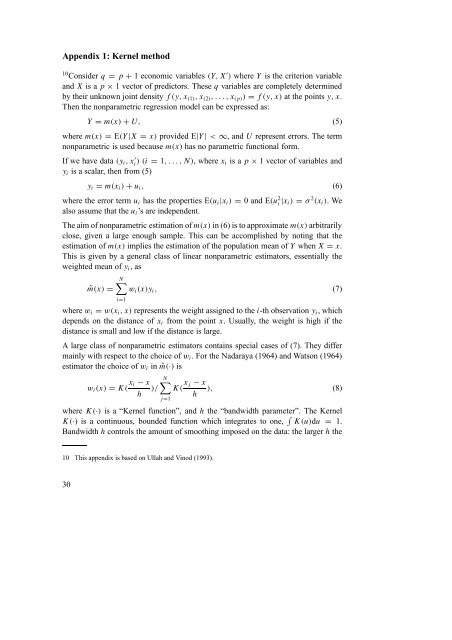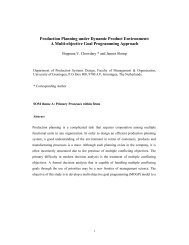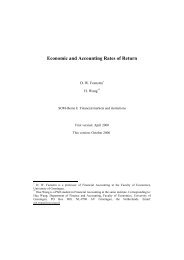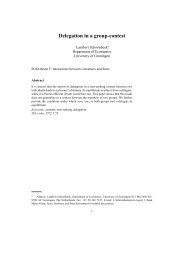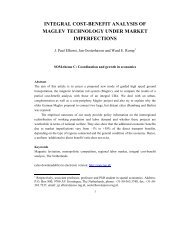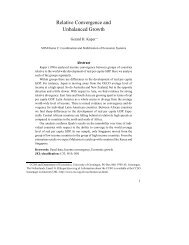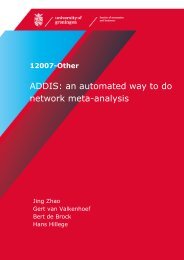Semiparametric Analysis to Estimate the Deal Effect Curve
Semiparametric Analysis to Estimate the Deal Effect Curve
Semiparametric Analysis to Estimate the Deal Effect Curve
Create successful ePaper yourself
Turn your PDF publications into a flip-book with our unique Google optimized e-Paper software.
Appendix 1: Kernel method<br />
10 Consider q = p + 1 economic variables (Y, X ′ ) where Y is <strong>the</strong> criterion variable<br />
and X is a p × 1 vec<strong>to</strong>r of predic<strong>to</strong>rs. These q variables are completely determined<br />
by <strong>the</strong>ir unknown joint density f(y,x(1),x(2),...,x(p)) = f(y,x) at <strong>the</strong> points y,x.<br />
Then <strong>the</strong> nonparametric regression model can be expressed as:<br />
Y = m(x) + U, (5)<br />
where m(x) = E(Y |X = x) provided E|Y | < ∞, andUrepresent errors. The term<br />
nonparametric is used because m(x) has no parametric functional form.<br />
If we have data (yi,x ′ i )(i=1,...,N),wherexiis a p × 1 vec<strong>to</strong>r of variables and<br />
yi is a scalar, <strong>the</strong>n from (5)<br />
yi = m(xi) + ui, (6)<br />
where <strong>the</strong> error term ui has <strong>the</strong> properties E(ui|xi) = 0andE(u2 i |xi) = σ 2 (xi). We<br />
also assume that <strong>the</strong> ui’s are independent.<br />
The aim of nonparametric estimation of m(x) in (6) is <strong>to</strong> approximate m(x) arbitrarily<br />
close, given a large enough sample. This can be accomplished by noting that <strong>the</strong><br />
estimation of m(x) implies <strong>the</strong> estimation of <strong>the</strong> population mean of Y when X = x.<br />
This is given by a general class of linear nonparametric estima<strong>to</strong>rs, essentially <strong>the</strong><br />
weighted mean of yi,as<br />
N<br />
ˆm(x) = wi(x)yi, (7)<br />
i=1<br />
where wi = w(xi,x)represents <strong>the</strong> weight assigned <strong>to</strong> <strong>the</strong> i-th observation yi,which<br />
depends on <strong>the</strong> distance of xi from <strong>the</strong> point x. Usually, <strong>the</strong> weight is high if <strong>the</strong><br />
distance is small and low if <strong>the</strong> distance is large.<br />
A large class of nonparametric estima<strong>to</strong>rs contains special cases of (7). They differ<br />
mainly with respect <strong>to</strong> <strong>the</strong> choice of wi. For <strong>the</strong> Nadaraya (1964) and Watson (1964)<br />
estima<strong>to</strong>r <strong>the</strong> choice of wi in ˆm(·) is<br />
wi(x) = K( xi − x<br />
)/<br />
h<br />
N<br />
j=1<br />
K( xj − x<br />
), (8)<br />
h<br />
where K(·) is a “Kernel function”, and h <strong>the</strong> “bandwidth parameter”. The Kernel<br />
K(·) is a continuous, bounded function which integrates <strong>to</strong> one, K(u)du = 1.<br />
Bandwidth h controls <strong>the</strong> amount of smoothing imposed on <strong>the</strong> data: <strong>the</strong> larger h <strong>the</strong><br />
10 This appendix is based on Ullah and Vinod (1993).<br />
30


